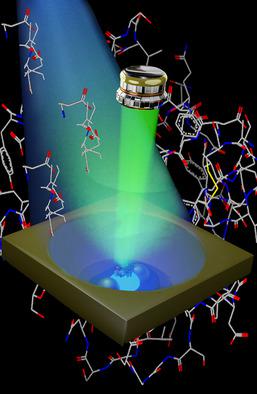当前位置:
X-MOL 学术
›
Phys. Status Solidi. Rapid Res. Lett.
›
论文详情
Our official English website, www.x-mol.net, welcomes your
feedback! (Note: you will need to create a separate account there.)
A Highly Directive Ultraviolet Plasmonic “Antenna-on-Reflector” for Single-Molecule Detection
Physica Status Solidi-Rapid Research Letters ( IF 2.5 ) Pub Date : 2021-03-19 , DOI: 10.1002/pssr.202000579 Prithu Roy 1, 2 , Alexey D. Bolshakov 2, 3
Physica Status Solidi-Rapid Research Letters ( IF 2.5 ) Pub Date : 2021-03-19 , DOI: 10.1002/pssr.202000579 Prithu Roy 1, 2 , Alexey D. Bolshakov 2, 3
Affiliation

|
Single-molecule detection (SMD) has been a hot topic for decades due to its extensive implementation in biomedical, chemical, physical, and material sciences. The methods used for single-molecule detection are generally variants of fluorescence and Raman spectroscopy, which employs plasmonic particles for hot-spot generation upon illumination. The signal generated by molecules in the hot spot is strong but not directive, so, <in most contemporary works, a nanomolar concentration is required to suppress noise from background molecules. However, at extremely low concentrations, biological samples vary with regard to conformation and interaction dynamics, so the most suitable dilution is micromolar. Thus an optical antenna that can both focus incident light at tight spots and be highly directive for the efficient collection of fluorescence is demanded. Herein, a nanoantenna in the shape of an aluminium hemisphere on a parabolic reflector providing both incident wave enhancement and efficient directive signal outcoupling is proposed and simulated. To achieve this feat, the focus of the parabolic reflector coincides spatially with the hot spot created by the plasmonic gap antenna. The structure shows broadband ( ) escalation in directivity, 24–28 dB. The calculated incident field enhancement in the detection volume of the plasmonic gap is up to .
中文翻译:

用于单分子检测的高度定向紫外等离子体“反射器天线”
由于在生物医学、化学、物理和材料科学中的广泛应用,单分子检测 (SMD) 几十年来一直是一个热门话题。用于单分子检测的方法通常是荧光和拉曼光谱的变体,后者采用等离子体粒子在照明时产生热点。热点中的分子产生的信号很强但不具有指导性,因此,<在大多数当代作品中,需要纳摩尔浓度来抑制来自背景分子的噪音。然而,在极低浓度下,生物样品的构象和相互作用动力学各不相同,因此最合适的稀释度是微摩尔。因此,需要一种光学天线,既可以将入射光聚焦在狭窄的点上,又可以高度定向以有效地收集荧光。在此,提出并模拟了抛物面反射器上的铝半球形状的纳米天线,该天线可提供入射波增强和有效的定向信号输出耦合。为了实现这一壮举,抛物面反射器的焦点在空间上与等离子体间隙天线产生的热点重合。结构显示宽带() 方向性升级,24–28 dB。在等离子体间隙的检测体积中计算的入射场增强高达.
更新日期:2021-03-19
中文翻译:

用于单分子检测的高度定向紫外等离子体“反射器天线”
由于在生物医学、化学、物理和材料科学中的广泛应用,单分子检测 (SMD) 几十年来一直是一个热门话题。用于单分子检测的方法通常是荧光和拉曼光谱的变体,后者采用等离子体粒子在照明时产生热点。热点中的分子产生的信号很强但不具有指导性,因此,<在大多数当代作品中,需要纳摩尔浓度来抑制来自背景分子的噪音。然而,在极低浓度下,生物样品的构象和相互作用动力学各不相同,因此最合适的稀释度是微摩尔。因此,需要一种光学天线,既可以将入射光聚焦在狭窄的点上,又可以高度定向以有效地收集荧光。在此,提出并模拟了抛物面反射器上的铝半球形状的纳米天线,该天线可提供入射波增强和有效的定向信号输出耦合。为了实现这一壮举,抛物面反射器的焦点在空间上与等离子体间隙天线产生的热点重合。结构显示宽带() 方向性升级,24–28 dB。在等离子体间隙的检测体积中计算的入射场增强高达.











































 京公网安备 11010802027423号
京公网安备 11010802027423号